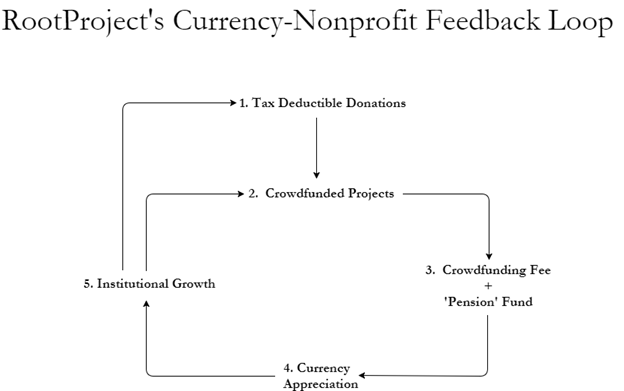The author, Dr. Nicholas Adams Judge, is a cofounder of RootProject. The other cofounder is Chris Place, a Y Combinator alumnus. Their nonprofit’s pre-ICO started July 10, 2017.
I’m a political economist. I wrote my doctoral dissertation on models of currency markets. The power of cryptocurrencies is greater than even those in the cryptocurrency community have understood.

I’m a ‘political economist’ instead of plain ‘economist’ because I focus on institutions as well as markets. Institutions determine who wins wars, what countries get to be free, and the pace of economic growth. The best way to think about cryptocurrencies? Ask what new institutional capacities they create.
To do that, put away your theory, put away your ideology. No one cares. Instead, think about feedback loops. Raise .99 to a large number, you get zero. Raise 1.01 to a large number, you approach infinity. If each day an institution’s efforts multiply its last day’s effects by 99%, it fails. If that number becomes 101%, it scales, it becomes a Google or Apple — until something pushes that number back below 1.
The genius of cryptocurrencies is that a liquid asset can be designed along with a new institution to create a currency value — institutional size feedback loop.
Call it the Feedback Loop theory of cryptocurrencies. Its most exciting consequence: Value can be created for investors from non profit-seeking behavior. The cryptocurrency brings the power of markets, and investor self-interest to the table; the nonprofit brings the moral relevance.
That does create dangers for nonprofits — but that’s like saying bitcoin can be used by smugglers, so let’s give it up. It misses the bigger story.
Let’s illustrate the major story here by what we’re doing at RootProject, whose pre-ICO is currently under way. Each part is simple. How they come together is illustrated in the figure above.
A crowdfunding platform lets people and institutions raise money for projects that help the neighborhood or local businesses. Instead of a typical crowdfunding fee, 10% of funds raised gets put into purchasing our currency, ROOTS, on the open market, driving price up. We call this the currency-as-fee model.
A nonprofit is based on a new set of programs in American cities. We know from recent data that these day-work programs are very effective at lifting people out of extreme poverty. Importantly, it also lets most donations be tax deductible, which in the United States is effectively a 30–40% government subsidy.
Workers (and one manager) get paid to complete the project out of the other 90% of funds (this 90% project spend rate is typical for the very best-run nonprofits). Workers get paid in USD, but then on top of that get 50% of that deposited in a medium-term pension fund that holds (only) our cryptocurrency. Like the 10% fee, the currency for the pension fund is purchased on the open market — again, driving prices up.
As the price of our token goes up, the nonprofit can expand, creating more demand for our cryptocurrency. Larger crowdfunded projects with bigger institutions involve burning currency.
Organic demand enters a system. That’s good: People who need jobs and exposure to things like shelters and medical care get them (more on that in our whitepaper). But what makes it really exciting is that that demand doesn’t just go away in a one-off event. It enters, by design, a feedback loop where it grows and grows, multiplying off itself.
It wouldn’t be possible without a cryptocurrency, and that fundamentally changes the institutional economics of nonprofit activity. Help us get this off the ground, and we’ll prove out a model where nonprofit work has the same market power as massive global profit-seeking corporations.
Our Pre-ICO runs this week. It’s a great investment for you and it will save people from freezing to death on the street. Be cynical if you want. Or help us build a new world.
Hi! I am a robot. I just upvoted you! I found similar content that readers might be interested in:
https://medium.com/@nickadamsjudge/youve-missed-the-most-important-part-of-cryptocurrencies-4f7ee5b9f1a1
Downvoting a post can decrease pending rewards and make it less visible. Common reasons:
Submit
Write good
Downvoting a post can decrease pending rewards and make it less visible. Common reasons:
Submit
Congratulations @rootproject! You received a personal award!
You can view your badges on your Steem Board and compare to others on the Steem Ranking
Vote for @Steemitboard as a witness to get one more award and increased upvotes!
Downvoting a post can decrease pending rewards and make it less visible. Common reasons:
Submit